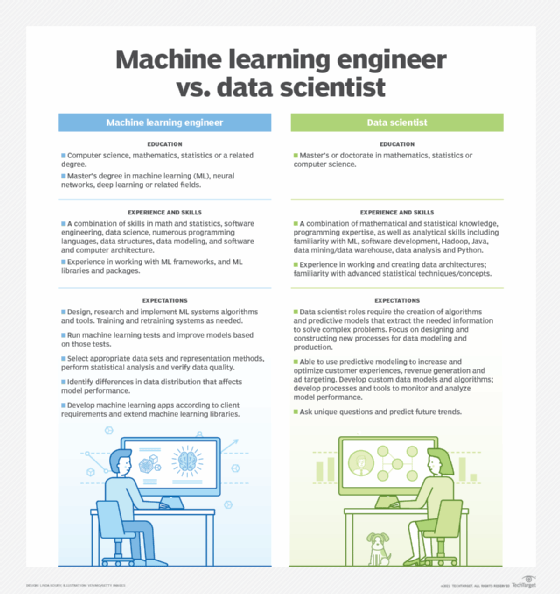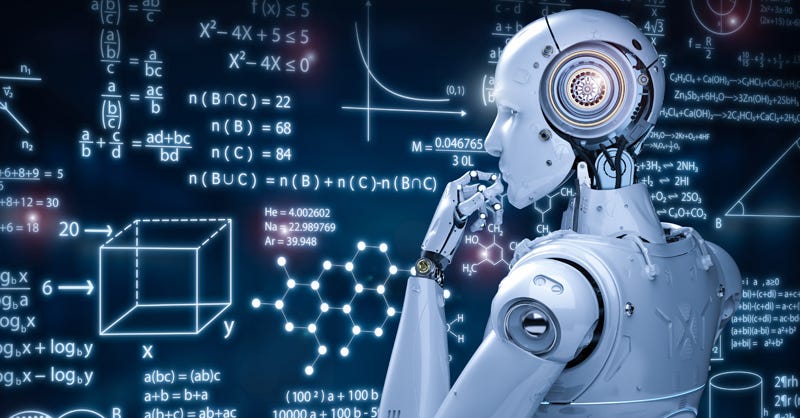All Categories
Featured
Table of Contents
- – The Only Guide to How To Become A Machine Lear...
- – How 19 Machine Learning Bootcamps & Classes To...
- – The Only Guide to Zuzoovn/machine-learning-fo...
- – Some Known Factual Statements About Machine L...
- – Facts About Software Engineering In The Age ...
- – Machine Learning Certification Training [Bes...
- – Advanced Machine Learning Course Fundamental...
Some people think that that's cheating. If someone else did it, I'm going to utilize what that individual did. I'm forcing myself to believe with the possible solutions.
Dig a little bit deeper in the mathematics at the start, just so I can develop that foundation. Santiago: Finally, lesson number seven. I do not think that you have to recognize the nuts and bolts of every formula before you use it.
I would certainly have to go and check back to really obtain a better intuition. That doesn't indicate that I can not resolve things making use of neural networks? It goes back to our arranging instance I believe that's just bullshit recommendations.
As a designer, I've worked with numerous, lots of systems and I've utilized several, lots of things that I do not recognize the nuts and screws of how it functions, although I comprehend the impact that they have. That's the final lesson on that thread. Alexey: The funny point is when I think of all these libraries like Scikit-Learn the algorithms they utilize inside to implement, for example, logistic regression or another thing, are not the like the algorithms we research in artificial intelligence classes.
The Only Guide to How To Become A Machine Learning Engineer [2022]
Also if we tried to discover to obtain all these basics of device knowing, at the end, the formulas that these libraries use are different. Santiago: Yeah, absolutely. I believe we require a whole lot much more pragmatism in the market.

I generally talk to those that want to work in the sector that desire to have their impact there. I do not risk to talk about that because I do not know.
Right there outside, in the industry, materialism goes a long method for certain. (32:13) Alexey: We had a remark that stated "Really feels even more like motivational speech than speaking about transitioning." Perhaps we ought to change. (32:40) Santiago: There you go, yeah. (32:48) Alexey: It is an excellent inspirational speech.
How 19 Machine Learning Bootcamps & Classes To Know can Save You Time, Stress, and Money.
One of the points I desired to ask you. First, allow's cover a couple of things. Alexey: Allow's begin with core devices and structures that you require to find out to actually transition.
I know Java. I know exactly how to utilize Git. Maybe I know Docker.
Santiago: Yeah, definitely. I think, number one, you ought to begin finding out a little bit of Python. Considering that you currently understand Java, I do not assume it's going to be a big shift for you.
Not due to the fact that Python coincides as Java, but in a week, you're gon na get a great deal of the distinctions there. You're gon na be able to make some progress. That's number one. (33:47) Santiago: After that you obtain particular core tools that are going to be utilized throughout your entire occupation.
The Only Guide to Zuzoovn/machine-learning-for-software-engineers
You obtain SciKit Learn for the collection of machine learning formulas. Those are tools that you're going to have to be utilizing. I do not recommend simply going and finding out regarding them out of the blue.
We can discuss specific courses later. Take among those courses that are mosting likely to start introducing you to some troubles and to some core concepts of device understanding. Santiago: There is a program in Kaggle which is an introduction. I don't bear in mind the name, but if you go to Kaggle, they have tutorials there for free.
What's good concerning it is that the only need for you is to know Python. They're going to present an issue and tell you just how to make use of decision trees to fix that specific problem. I assume that procedure is exceptionally effective, due to the fact that you go from no equipment discovering history, to recognizing what the issue is and why you can not address it with what you understand now, which is straight software design practices.
Some Known Factual Statements About Machine Learning Online Course - Applied Machine Learning
On the other hand, ML engineers focus on structure and releasing machine learning models. They concentrate on training versions with information to make predictions or automate tasks. While there is overlap, AI designers handle even more diverse AI applications, while ML designers have a narrower concentrate on machine understanding algorithms and their sensible execution.

Artificial intelligence engineers concentrate on creating and releasing maker understanding designs right into production systems. They work on engineering, making sure models are scalable, efficient, and integrated into applications. On the various other hand, information researchers have a more comprehensive function that includes information collection, cleansing, exploration, and structure models. They are often in charge of removing insights and making data-driven decisions.
As organizations significantly take on AI and maker knowing technologies, the need for proficient professionals expands. Equipment understanding engineers function on advanced jobs, add to technology, and have competitive incomes.
ML is fundamentally various from standard software growth as it concentrates on training computer systems to pick up from data, as opposed to programming explicit guidelines that are executed methodically. Unpredictability of outcomes: You are possibly utilized to writing code with predictable outcomes, whether your feature runs as soon as or a thousand times. In ML, nonetheless, the end results are much less specific.

Pre-training and fine-tuning: Exactly how these designs are educated on large datasets and after that fine-tuned for particular tasks. Applications of LLMs: Such as message generation, sentiment evaluation and information search and retrieval. Papers like "Attention is All You Need" by Vaswani et al., which presented transformers. On the internet tutorials and training courses focusing on NLP and transformers, such as the Hugging Face training course on transformers.
Facts About Software Engineering In The Age Of Ai Uncovered
The capability to take care of codebases, merge changes, and settle disputes is simply as vital in ML growth as it remains in traditional software tasks. The abilities created in debugging and screening software applications are very transferable. While the context might change from debugging application logic to identifying issues in information handling or version training the underlying concepts of organized examination, hypothesis testing, and repetitive refinement are the very same.
Device understanding, at its core, is greatly dependent on data and likelihood theory. These are vital for comprehending how algorithms learn from data, make forecasts, and evaluate their efficiency. You must consider becoming comfy with principles like analytical relevance, circulations, theory screening, and Bayesian reasoning in order to style and translate models efficiently.
For those interested in LLMs, an extensive understanding of deep understanding designs is valuable. This consists of not just the mechanics of neural networks however additionally the style of specific designs for different usage cases, like CNNs (Convolutional Neural Networks) for image handling and RNNs (Recurrent Neural Networks) and transformers for sequential information and natural language processing.
You should understand these concerns and discover methods for determining, reducing, and connecting about prejudice in ML models. This consists of the potential influence of automated decisions and the honest effects. Lots of models, especially LLMs, call for considerable computational sources that are typically provided by cloud platforms like AWS, Google Cloud, and Azure.
Structure these skills will not just promote an effective transition into ML yet likewise make sure that designers can add successfully and responsibly to the advancement of this dynamic area. Theory is important, yet nothing defeats hands-on experience. Beginning working with jobs that enable you to use what you have actually discovered in a sensible context.
Develop your projects: Beginning with easy applications, such as a chatbot or a text summarization device, and progressively raise complexity. The field of ML and LLMs is rapidly evolving, with brand-new advancements and innovations emerging on a regular basis.
Machine Learning Certification Training [Best Ml Course] - An Overview
Contribute to open-source projects or write blog articles regarding your learning journey and projects. As you get expertise, begin looking for possibilities to integrate ML and LLMs into your job, or seek brand-new roles concentrated on these modern technologies.

Possible use instances in interactive software program, such as referral systems and automated decision-making. Comprehending uncertainty, basic statistical measures, and chance distributions. Vectors, matrices, and their role in ML formulas. Mistake minimization methods and slope descent clarified just. Terms like model, dataset, functions, tags, training, inference, and validation. Data collection, preprocessing strategies, model training, evaluation procedures, and deployment factors to consider.
Choice Trees and Random Woodlands: User-friendly and interpretable versions. Matching issue kinds with appropriate models. Feedforward Networks, Convolutional Neural Networks (CNNs), Recurrent Neural Networks (RNNs).
Continual Integration/Continuous Release (CI/CD) for ML workflows. Design surveillance, versioning, and efficiency monitoring. Finding and addressing changes in design efficiency over time.
Advanced Machine Learning Course Fundamentals Explained

Training course OverviewMachine understanding is the future for the future generation of software application specialists. This program functions as an overview to artificial intelligence for software engineers. You'll be introduced to 3 of the most relevant elements of the AI/ML technique; managed discovering, semantic networks, and deep discovering. You'll grasp the differences in between conventional programming and artificial intelligence by hands-on growth in supervised knowing before building out complicated dispersed applications with semantic networks.
This training course works as an overview to equipment lear ... Show Much more.
Table of Contents
- – The Only Guide to How To Become A Machine Lear...
- – How 19 Machine Learning Bootcamps & Classes To...
- – The Only Guide to Zuzoovn/machine-learning-fo...
- – Some Known Factual Statements About Machine L...
- – Facts About Software Engineering In The Age ...
- – Machine Learning Certification Training [Bes...
- – Advanced Machine Learning Course Fundamental...
Latest Posts
Full Guide: How To Prepare For A Technical Coding Interview
Best Resources To Practice Software Engineer Interview Questions
Software Engineer Interviews: Everything You Need To Know To Succeed
More
Latest Posts
Full Guide: How To Prepare For A Technical Coding Interview
Best Resources To Practice Software Engineer Interview Questions
Software Engineer Interviews: Everything You Need To Know To Succeed